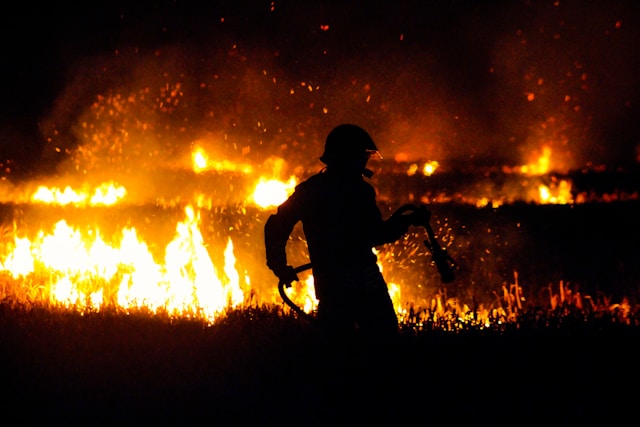The 2025 fires set a historic record for burned area in the European Union. Climate change, rural depopulation, and lack of prevention demand a strategic rethink.
This summer, Southern Europe burned once again, enduring weeks in which fire took center stage, forcing mass evacuations, overwhelming emergency systems, and leaving behind a desolate landscape. According to data from the European Commission’s Joint Research Centre (JRC), by August 26 more than 1,028,000 hectares had burned in the European Union, the highest figure recorded since reliable measurements began. For perspective, the same date in 2024 saw 222,132 hectares burned.
The countries most affected this summer were:
1. Spain – nearly 403,000 hectares burned.
2. Portugal – around 275,000 hectares.
3. Romania – approximately 126,000 hectares.
4. France – more than 35,600 hectares.
5. Other countries experiencing severe fires include Greece, Turkey, Cyprus, and Albania.
Together, Spain and Portugal account for over 60% of the total burned area in the EU.
Why each summer is worse
The Organization for Security and Cooperation in Europe (OSCE) warns that climate change is intensifying heatwaves, reducing soil moisture, and lengthening the fire season. Adding to this is a particularly critical demographic phenomenon: rural depopulation. Abandoned fields accumulate dry vegetation that acts as perfect fuel.
Economic and environmental factors also play a role. In Galicia, for example, the expansion of eucalyptus plantations—a highly flammable species—has led to what some call “eucalyptus fever”: forests designed to maximize economic benefit, but at a high cost in terms of fire vulnerability.
How wildfires have changed
Contemporary wildfires have evolved into more extreme, complex, and difficult-to-fight phenomena. These fires surpass not only traditional operational capacity but also the classical understanding of fire behavior. This new dynamic is characterized by:
-
Greater intensity and speed: fires release energy so concentrated that conventional suppression tools become obsolete.
-
Fire-generated atmospheric phenomena: such as pyrocumulonimbus clouds, which alter local weather conditions and complicate control efforts.
-
Unpredictable spread patterns: due to the complex interaction of extreme weather, fuel availability, and topography, fire behavior becomes chaotic and unexpected.
-
Climate feedback: massive CO₂ emissions amplify climate change, which in turn creates conditions even more favorable for future fires.
These dynamics demonstrate how current wildfires challenge both past management models and our predictive capacity, demanding a next-level prevention strategy.
Impacts beyond the fire
The consequences of these fires do not end when the flames are extinguished:
-
Climate: according to the Copernicus Atmosphere Monitoring Service, the 2025 fires released over 38 million tons of CO₂, emissions equivalent to those of entire countries like Portugal.
-
Public health: wildfire smoke (PM2.5) is far more harmful than previously thought. A recent ISGlobal study estimates that smoke from wildfires poses a higher mortality risk than non-fire-related particulate matter. It is estimated to cause approximately 535 deaths per year, including 31 from respiratory diseases and 184 from cardiovascular causes.
-
Tourism: Mediterranean regions experienced mass evacuations and cancellations.
European debate: prevention vs. reaction
The summer of 2025 highlighted not only the scale of the fires but also structural gaps in risk management, sparking intense debate at both European and national levels:
At the European level:
-
Coordination and solidarity: the EU Civil Protection Mechanism deployed aircraft and teams to support Portugal, Greece, and Albania. While this rapid response saved lives and limited damage, it shows that Europe still relies on reactive measures, lacking a common preventive policy to reduce recurrence and fire severity.
-
Investment in prevention: the European Court of Auditors reports that spending on prevention has fallen by 50% in the last decade, even though every euro invested could save up to ten in future damages.
-
Climate and energy policies: debates focus on how the energy transition and land-use planning influence fire vulnerability, especially in forested and peri-urban areas.
-
EU forest management regulations: there is a review of the need for common standards requiring member states to implement active management, fuel reduction, and degraded ecosystem restoration.
-
Information and data sharing: coordination on early warnings, satellites, and predictive models is still fragmented, causing delays in response and limiting effective prevention.
At the national level:
-
Legislation and spatial planning: several countries are considering reforms to urban planning laws to reduce the wildland-urban interface and restrict new construction in high-risk areas.
-
National prevention funds: governments such as Spain and Portugal are evaluating increased budgets for forest clearing, firebreak creation, and drone surveillance after years of cuts.
-
Citizen participation and prevention culture: discussions focus on encouraging local community involvement through education programs, drills, and local self-protection plans, especially in rural areas.
-
Firefighter training and resources: there is debate over strengthening specialized training, improving working conditions and stability, enhancing coordination between teams, and incorporating new technologies for large-scale fires.
Overall, the debate shows that there is no single solution: effective fire management requires combining coherent European policies with national actions tailored to local realities. Only then can reactive measures evolve into a solid strategy of prevention and resilience against increasingly extreme fires.
Prevention as a key strategy
The 2025 fires demonstrate that simply increasing emergency resources is not enough: true risk reduction requires anticipating fires before they occur. Prevention not only saves lives but also protects ecosystems, infrastructure, and the economy.
Key strategies include:
-
Active land management: implementing forest management plans, reducing flammable monocultures, restoring mixed forests, and creating mosaic landscapes. These measures slow fire spread and make fires more controllable.
-
Community training and participation: educating local populations, developing self-protection plans, and encouraging volunteer surveillance enables early response and reduces exposure of people and property.
-
Advanced technology use: early detection systems using satellites, drones, and remote sensors, combined with predictive fire behavior models, help anticipate emergencies and optimize resource deployment.
-
Long-term planning and funding: ensuring stable, sustainable resources for prevention is more efficient than dealing with subsequent damages.
-
Environmental and climate integration: prevention should include ecosystem restoration, carbon emission reduction, and climate adaptation, creating landscapes more resilient to extreme fires.
Prevention consolidates as an integrated strategy: it combines territorial management, education, technology, and planning, transforming vulnerability into effective resilience and reducing fire severity before they escalate into disasters.







